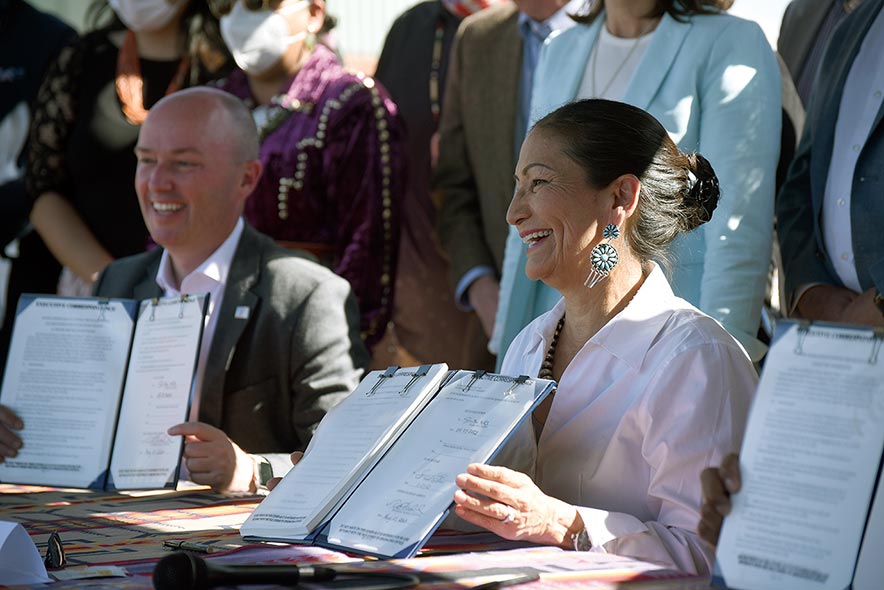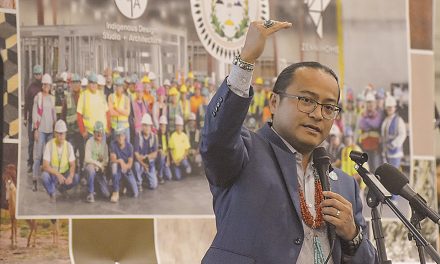
Long road leads to final settlement

Navajo Times | Krista Allen
U.S. Secretary of the Interior Deb Haaland holds up the agreement for the Navajo federal reserved water rights settlement outside the Welcome Center in Oljato-Monument Valley, Utah, on Friday morning. U.S. Gov. Spencer J. Cox, left, along with Navajo Nation President, also signed.
WINDOW ROCK
The Naabik’iyati’ Committee approved a revised Navajo-Utah water rights agreement last Thursday and on Friday the legislation was signed by President Jonathan Nez, Utah Governor Spencer Cox and Secretary of Interior Deb Haaland.
Their signatures at the Monument Valley Welcome Center marked the end of a long road for the settlement.
The amount of funds received by the settlement fund is approximately $210 million, which will go towards water infrastructure projects for Diné.
The Navajo-Utah agreement has a history that dates back to April 2003. It began due to Diné communities in Utah lacking water infrastructure that impacted their health, economy and welfare.
Throughout 2003, discussion of water rights in Utah began to determine if the water rights claims made by the Nation could be resolved through a settlement rather than litigation.
In August 2003, the Navajo Nation and the state of Utah entered settlement negotiations.
Talks about a settlement and water rights occurred over the next 12 years into 2015 when an agreement was reached in late in the year.
In early 2016, the Navajo Nation Council approved the proposed Navajo-Utah Water Rights Settlement Agreement which gave the Naabik’iyati’
Committee the authorization to approve the revised settlement and authorize the president to sign.
In 2020, Congress approved the settlement act as part of the Comprehensive Appropriations Act of 2021, which recognized the water rights of the Nation in Utah and authorized funding for water infrastructure development.
The act was signed into law by the U.S. President Donald Trump in December 2020.
Since the act was passed, Navajo Nation Department of Justice worked with Utah attorneys to revise the water rights agreement to be consistent with the act.
Michelle Brown-Yazzie, assistant attorney general for the Water Rights Unit at DOJ, told Naabik’iyati’ the specific revisions that were made to the agreement.
The first revision was the settlement being a fund-based settlement rather than the project-based settlement that it was originally designed to be in 2015 and 2016. The fund-based settlement is what was approved and funded by Congress.
“A fund-based settlement gives discretion or more discretion to the Navajo Nation to decide, plan, and manage water infrastructure projects and the established trust fund related to the settlement.” Brown-Yazzie said.
“A majority of the revisions transfer authority and responsibilities from the secretary to the Navajo Nation government to make project and funding decisions to fulfill the settlement,” she said.
During the Naabik’iyati’ regular meeting, the bill was presented by Council Delegate Charlaine Tso who represents Mexican Water, To’likan, Teesnospos, Aneth and Red Mesa.
“Over the years, the Utah Navajo chapters have put in a lot of their input as to what the needs are,” Tso said.
All seven Utah chapters are in support of the legislation, she said.
“I am very proud that with the 24th Navajo Nation Council, we are going to be moving forward with one of the main agreements that have taken a very long course of time and as we do say, ‘To’ei’iina,’” Tso said.
“Life is water and we stand by that statement, we live by that statement, we have that belief,” she said.








 Highway 264,
Highway 264, I-40, WB @ Winslow
I-40, WB @ Winslow